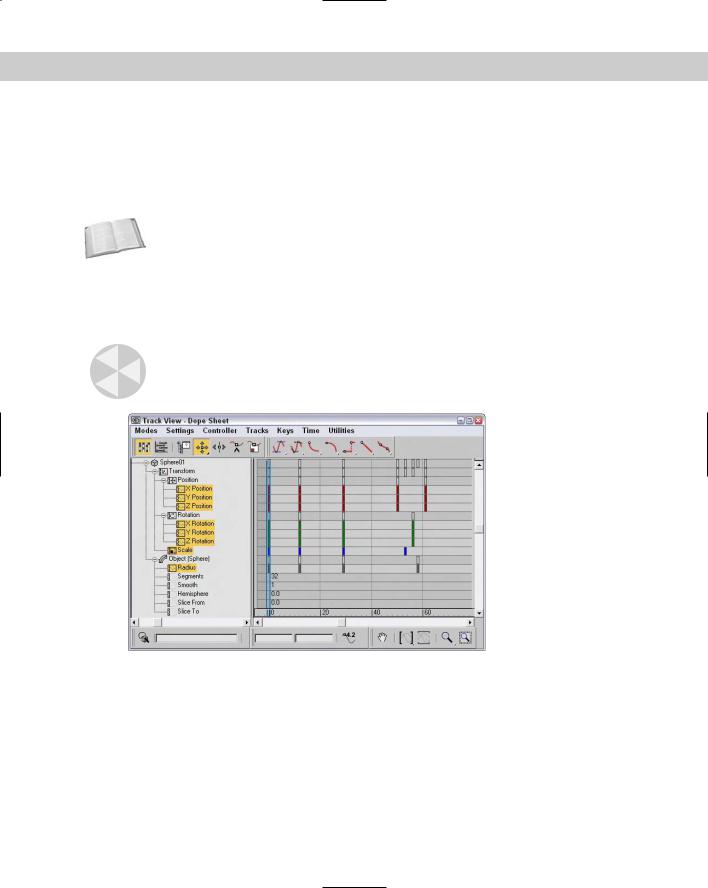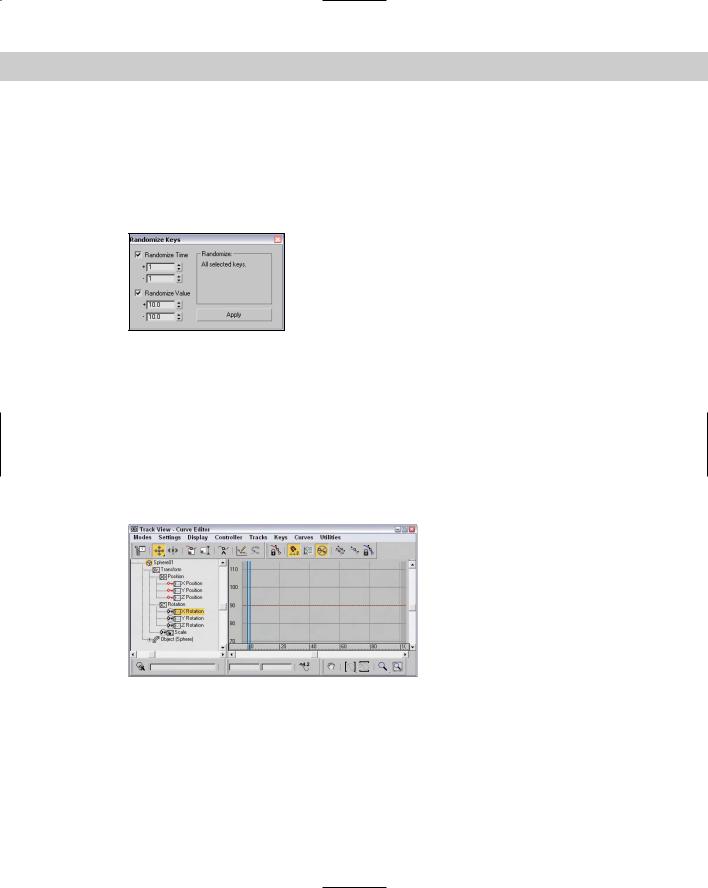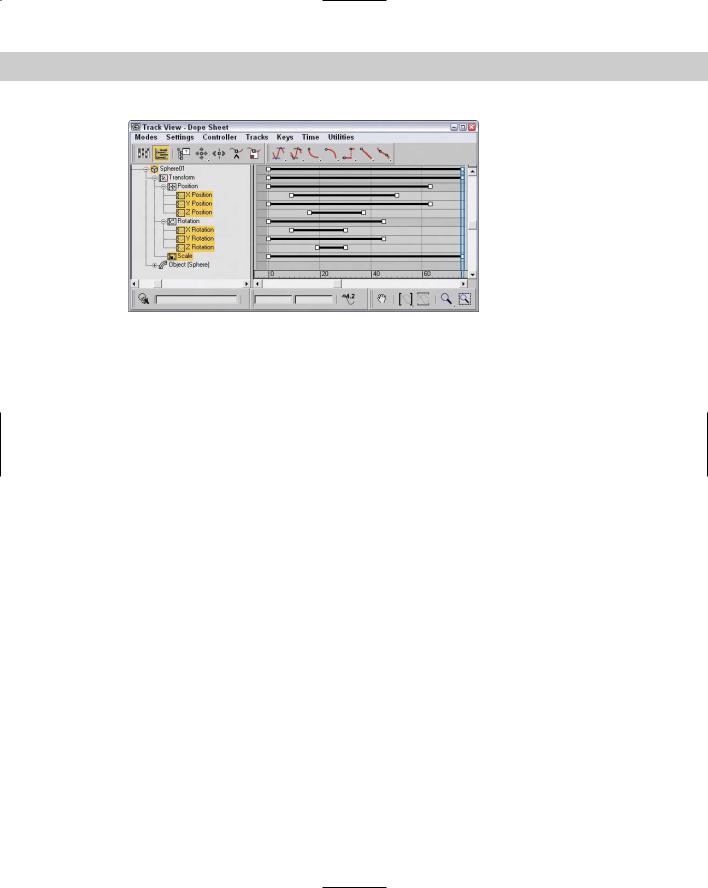
- •Preface
- •About This Book
- •Acknowledgments
- •Contents at a Glance
- •Contents
- •Relaxing at the Beach
- •Dressing the Scene
- •Animating Motion
- •Rendering the Final Animation
- •Summary
- •The Interface Elements
- •Using the Menus
- •Using the Toolbars
- •Using the Viewports
- •Using the Command Panel
- •Using the Lower Interface Bar Controls
- •Interacting with the Interface
- •Getting Help
- •Summary
- •Understanding 3D Space
- •Using the Viewport Navigation Controls
- •Configuring the Viewports
- •Working with Viewport Backgrounds
- •Summary
- •Working with Max Scene Files
- •Setting File Preferences
- •Importing and Exporting
- •Referencing External Objects
- •Using the File Utilities
- •Accessing File Information
- •Summary
- •Customizing Modify and Utility Panel Buttons
- •Working with Custom Interfaces
- •Configuring Paths
- •Selecting System Units
- •Setting Preferences
- •Summary
- •Creating Primitive Objects
- •Exploring the Primitive Object Types
- •Summary
- •Selecting Objects
- •Setting Object Properties
- •Hiding and Freezing Objects
- •Using Layers
- •Summary
- •Cloning Objects
- •Understanding Cloning Options
- •Mirroring Objects
- •Cloning over Time
- •Spacing Cloned Objects
- •Creating Arrays of Objects
- •Summary
- •Working with Groups
- •Building Assemblies
- •Building Links between Objects
- •Displaying Links and Hierarchies
- •Working with Linked Objects
- •Summary
- •Using the Schematic View Window
- •Working with Hierarchies
- •Setting Schematic View Preferences
- •Using List Views
- •Summary
- •Working with the Transformation Tools
- •Using Pivot Points
- •Using the Align Commands
- •Using Grids
- •Using Snap Options
- •Summary
- •Exploring the Modifier Stack
- •Exploring Modifier Types
- •Summary
- •Exploring the Modeling Types
- •Working with Subobjects
- •Modeling Helpers
- •Summary
- •Drawing in 2D
- •Editing Splines
- •Using Spline Modifiers
- •Summary
- •Creating Editable Mesh and Poly Objects
- •Editing Mesh Objects
- •Editing Poly Objects
- •Using Mesh Editing Modifiers
- •Summary
- •Introducing Patch Grids
- •Editing Patches
- •Using Modifiers on Patch Objects
- •Summary
- •Creating NURBS Curves and Surfaces
- •Editing NURBS
- •Working with NURBS
- •Summary
- •Morphing Objects
- •Creating Conform Objects
- •Creating a ShapeMerge Object
- •Creating a Terrain Object
- •Using the Mesher Object
- •Working with BlobMesh Objects
- •Creating a Scatter Object
- •Creating Connect Objects
- •Modeling with Boolean Objects
- •Creating a Loft Object
- •Summary
- •Understanding the Various Particle Systems
- •Creating a Particle System
- •Using the Spray and Snow Particle Systems
- •Using the Super Spray Particle System
- •Using the Blizzard Particle System
- •Using the PArray Particle System
- •Using the PCloud Particle System
- •Using Particle System Maps
- •Controlling Particles with Particle Flow
- •Summary
- •Understanding Material Properties
- •Working with the Material Editor
- •Using the Material/Map Browser
- •Using the Material/Map Navigator
- •Summary
- •Using the Standard Material
- •Using Shading Types
- •Accessing Other Parameters
- •Using External Tools
- •Summary
- •Using Compound Materials
- •Using Raytrace Materials
- •Using the Matte/Shadow Material
- •Using the DirectX 9 Shader
- •Applying Multiple Materials
- •Material Modifiers
- •Summary
- •Understanding Maps
- •Understanding Material Map Types
- •Using the Maps Rollout
- •Using the Map Path Utility
- •Using Map Instances
- •Summary
- •Mapping Modifiers
- •Using the Unwrap UVW modifier
- •Summary
- •Working with Cameras
- •Setting Camera Parameters
- •Summary
- •Using the Camera Tracker Utility
- •Summary
- •Using Multi-Pass Cameras
- •Creating Multi-Pass Camera Effects
- •Summary
- •Understanding the Basics of Lighting
- •Getting to Know the Light Types
- •Creating and Positioning Light Objects
- •Viewing a Scene from a Light
- •Altering Light Parameters
- •Working with Photometric Lights
- •Using the Sunlight and Daylight Systems
- •Using Volume Lights
- •Summary
- •Selecting Advanced Lighting
- •Using Local Advanced Lighting Settings
- •Tutorial: Excluding objects from light tracing
- •Summary
- •Understanding Radiosity
- •Using Local and Global Advanced Lighting Settings
- •Working with Advanced Lighting Materials
- •Using Lighting Analysis
- •Summary
- •Using the Time Controls
- •Working with Keys
- •Using the Track Bar
- •Viewing and Editing Key Values
- •Using the Motion Panel
- •Using Ghosting
- •Animating Objects
- •Working with Previews
- •Wiring Parameters
- •Animation Modifiers
- •Summary
- •Understanding Controller Types
- •Assigning Controllers
- •Setting Default Controllers
- •Examining the Various Controllers
- •Summary
- •Working with Expressions in Spinners
- •Understanding the Expression Controller Interface
- •Understanding Expression Elements
- •Using Expression Controllers
- •Summary
- •Learning the Track View Interface
- •Working with Keys
- •Editing Time
- •Editing Curves
- •Filtering Tracks
- •Working with Controllers
- •Synchronizing to a Sound Track
- •Summary
- •Understanding Your Character
- •Building Bodies
- •Summary
- •Building a Bones System
- •Using the Bone Tools
- •Using the Skin Modifier
- •Summary
- •Creating Characters
- •Working with Characters
- •Using Character Animation Techniques
- •Summary
- •Forward versus Inverse Kinematics
- •Creating an Inverse Kinematics System
- •Using the Various Inverse Kinematics Methods
- •Summary
- •Creating and Binding Space Warps
- •Understanding Space Warp Types
- •Combining Particle Systems with Space Warps
- •Summary
- •Understanding Dynamics
- •Using Dynamic Objects
- •Defining Dynamic Material Properties
- •Using Dynamic Space Warps
- •Using the Dynamics Utility
- •Using the Flex Modifier
- •Summary
- •Using reactor
- •Using reactor Collections
- •Creating reactor Objects
- •Calculating and Previewing a Simulation
- •Constraining Objects
- •reactor Troubleshooting
- •Summary
- •Understanding the Max Renderers
- •Previewing with ActiveShade
- •Render Parameters
- •Rendering Preferences
- •Creating VUE Files
- •Using the Rendered Frame Window
- •Using the RAM Player
- •Reviewing the Render Types
- •Using Command-Line Rendering
- •Creating Panoramic Images
- •Getting Printer Help
- •Creating an Environment
- •Summary
- •Creating Atmospheric Effects
- •Using the Fire Effect
- •Using the Fog Effect
- •Summary
- •Using Render Elements
- •Adding Render Effects
- •Creating Lens Effects
- •Using Other Render Effects
- •Summary
- •Using Raytrace Materials
- •Using a Raytrace Map
- •Enabling mental ray
- •Summary
- •Understanding Network Rendering
- •Network Requirements
- •Setting up a Network Rendering System
- •Starting the Network Rendering System
- •Configuring the Network Manager and Servers
- •Logging Errors
- •Using the Monitor
- •Setting up Batch Rendering
- •Summary
- •Compositing with Photoshop
- •Video Editing with Premiere
- •Video Compositing with After Effects
- •Introducing Combustion
- •Using Other Compositing Solutions
- •Summary
- •Completing Post-Production with the Video Post Interface
- •Working with Sequences
- •Adding and Editing Events
- •Working with Ranges
- •Working with Lens Effects Filters
- •Summary
- •What Is MAXScript?
- •MAXScript Tools
- •Setting MAXScript Preferences
- •Types of Scripts
- •Writing Your Own MAXScripts
- •Learning the Visual MAXScript Editor Interface
- •Laying Out a Rollout
- •Summary
- •Working with Plug-Ins
- •Locating Plug-Ins
- •Summary
- •Low-Res Modeling
- •Using Channels
- •Using Vertex Colors
- •Rendering to a Texture
- •Summary
- •Max and Architecture
- •Using AEC Objects
- •Using Architectural materials
- •Summary
- •Tutorial: Creating Icy Geometry with BlobMesh
- •Tutorial: Using Caustic Photons to Create a Disco Ball
- •Summary
- •mental ray Rendering System
- •Particle Flow
- •reactor 2.0
- •Schematic View
- •BlobMesh
- •Spline and Patch Features
- •Import and Export
- •Shell Modifier
- •Vertex Paint and Channel Info
- •Architectural Primitives and Materials
- •Minor Improvements
- •Choosing an Operating System
- •Hardware Requirements
- •Installing 3ds max 6
- •Authorizing the Software
- •Setting the Display Driver
- •Updating Max
- •Moving Max to Another Computer
- •Using Keyboard Shortcuts
- •Using the Hotkey Map
- •Main Interface Shortcuts
- •Dialog Box Shortcuts
- •Miscellaneous Shortcuts
- •System Requirements
- •Using the CDs with Windows
- •What’s on the CDs
- •Troubleshooting
- •Index

Chapter 33 Working with the Track View 829
Working with Keys
Keys define the main animation points in an animation. Max interpolates all the positions and values between the key points to generate the animation. Using the Track View, you can edit these animation keys with precision. Keys can be edited in either layout, but are probably easiest to edit in the Dope Sheet layout with the Edit Keys button enabled.
Cross- |
Chapter 30, “Animation Basics,” covers key creation in more detail. |
Reference |
|
In the Curve Editor, keys are shown as small squares positioned along the curve. In the Dope Sheet, keys are shown as colored lines that extend across the applicable tracks, as shown in Figure 33-5. The keys for the Position track are red, the Rotation track keys are green, the Scale track keys are blue, and the parameter tracks are gray. Parent tracks (such as an object’s name) are colored gray. Selecting a parent key selects all its children keys. Any selected keys appear white. A track title that includes a key is highlighted yellow.
Caution |
If the Key pane is not wide enough, then a key is shown as a thick, black line. |
Figure 33-5: In the Dope Sheet, Position keys are red, Rotation keys are green, Scale keys are blue, and parameter keys are gray.
Selecting keys
Before you can move and edit keys, you need to be able to select them. Just like selecting keys on the Track Bar, you select keys by clicking them. Selected keys turn white. To select multiple keys, hold down the Ctrl key while clicking several keys, or drag an outline over several keys to select them. Click away from the keys to deselect all the selected keys.

830 Part VII Animation
|
With a key or multiple keys selected, you can lock the selection with the Lock Selection but- |
|
ton. The spacebar is the keyboard shortcut for this button. With the selection locked, you |
|
cannot select any new keys. |
Tip |
If you want to access a specific parameter in the Track View, you can right-click the param- |
|
eter and select the Show in Track View command from the pop-up menu, and the Track View |
|
loads with the parameter visible. |
Using soft selection
The Keys menu also includes a Use Soft Select option. This feature is similar to the soft selection found in the Modify panel when working on subobject, except that it works with keys. The Keys Use Soft Select menu command opens a simple toolbar where you can enable soft selection and set the Range and Falloff values.
When enabled, all keys within a specified range are also selected and moved to a lesser degree than the selected key. When enabled, the function curve is displayed with a gradient for the Curve Editor layout and as a gradient across the key markers in the Dope Sheet layout. This shows the range and falloff for the curve.
Adding and deleting keys
You can add a key by clicking the Add Keys button (or pressing the A key) and clicking the location where the new key should appear. Each new key is set with the interpolated value between the existing keys.
To delete keys, select the keys, and click the Delete Keys button or press the Delete key on the keyboard. By selecting the track name and pressing the Delete key, you can delete all keys in a track.
Moving, sliding, and scaling keys
The Move Keys button (keyboard shortcut, M) lets you select and move a key to a new location. You can clone keys by holding down the Shift key while moving a key. Using the flyout buttons, you can select to restrict the movement horizontally or vertically. You can also move the selected key to the cursor’s location with the Keys Align to Cursor menu command.
The Slide Keys button lets you select a key and move all adjacent keys in unison to the left or right. If the selected key is moved to the right, all keys from that key to the end of the animation slide to the right. If the key is moved to the left, then all keys to the beginning of the animation slide to the left.
The Scale Keys button lets you move a group of keys closer together or farther apart. The scale center is the current frame. You can use the Shift key to clone keys while dragging.
If the Snap Frames (keyboard shortcut, S) button is enabled, then the selected key snaps to the nearest key as it is moved. This makes aligning keys to the same frame easy.
Editing keys
To edit the key parameters for any controller, click the Properties button; this opens the Key Info dialog box for most controllers. You can also access this dialog box by right-clicking a key and selecting Properties from the pop-up menu. These commands can also be used when multiple keys on the same or on different tracks are selected.

Chapter 33 Working with the Track View 831
Using the Randomize Keys utility
The Randomize Keys utility lets you generate random time or key positions with an offset value. To access this utility, select the track of keys that you want to randomize and choose Utilities Track View Utilities to open the Track View Utilities dialog box. From this dialog box, select Randomize Keys from the list of utilities and click OK; the Randomize Keys utility dialog box opens, as shown in Figure 33-6.
Figure 33-6: Use the Randomize Keys utility to create random key positions and values.
In this dialog box, you can specify positive and negative shift values for both Time and Value. Click the Apply button to apply the randomization process.
Displaying keyable icons
If you’re not careful, you could animate a track that you didn’t mean to (especially with the Auto Key mode enabled). By marking a track as non-keyable or keyable, you can control which tracks can be animated. To do this, open the Curves toolbar and click the Show Keyable Icons button. This places a small red key icon to the left of each track that can be animated. You can then click the icon to change it to a non-keyable track. Figure 33-7 shows the Curve Editor with this feature enabled.
Figure 33-7: The Keyable Icons feature displays an icon next to all tracks that can be keyed.
Editing Time
In some cases, directly working with keys isn’t what you want to do. For example, if you need to change the animation length from six seconds to five seconds, you want to work in the Dope Sheet’s Edit Ranges mode. To switch to this mode, click the Edit Ranges button on the Keys toolbar. In this mode, the key ranges are displayed as black lines with square markers on either end, as shown in Figure 33-8.

832 Part VII Animation
Figure 33-8: Click the Edit Ranges button to display the key ranges in the Key pane.
Selecting time and the Select Keys by Time utility
Before you can scale, cut, copy, or paste time, you need to select a track and then select a time block. To select a section of time, click the Select Time button and drag the mouse over the time block.
The Select Keys by Time utility lets you select all the keys within a given time block by entering the frame or time values. To use this utility, click the Track View Utilities button to open the Track View Utilities dialog box, and select the Select Keys by Time utility from the list. Then in the Select Keys by Time dialog box, enter the Start and End values to complete the selection.
Deleting, cutting, copying, and pasting time
After you select a block of time, you can delete it by clicking the Delete Time button. Another way to delete a block of time is to use the Cut Time button, which removes the selected time block but places a copy of it on the clipboard for pasting. The Copy Time button also adds the time block to the clipboard for pasting, but it leaves the selected time in the track.
After you copy a time block to the clipboard, you can paste it to a different location within the Track View. The track where you paste it must be of the same type as the one from which you copied it.
All keys within the time block are also pasted, and you can select whether they are pasted relatively or absolutely. Absolute pasting adds keys with the exact values as the ones on the clipboard. Relative pasting adds the key value to the current initial value at the place where the key is pasted.
You can enable the Exclude Left End Point and Exclude Right End Point buttons on the Extras toolbar when pasting multiple sections next to each other. By excluding either end point, the time block loops seamlessly.
